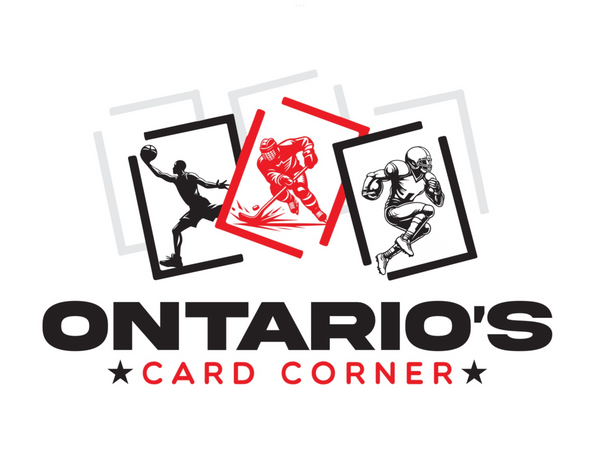Grading 202: A Deeper Dive into the World of Sports Card Grading
Share
Hello, collectors! Coleman Bennett here, owner of Ontario’s Card Corner. In our earlier blog, Grading 101, we covered the basics of card grading—what it is, why it matters, and how it works. Now, let’s take things a step further with Grading 202. We’ll explore the history of grading, dive into the grading companies shaping the hobby, and examine how the grading landscape has evolved over the years.
1. The History of Grading
A. The Origins of Grading
-
In the early days of card collecting, condition was subjective, often judged informally by buyers and sellers. Terms like "mint" or "near mint" lacked standard definitions, leading to inconsistencies.
-
The late 1980s and early 1990s marked a turning point with the rise of third-party grading companies. These organizations brought standardization and credibility to the hobby by introducing objective criteria for evaluating card condition.
B. The First Grading Companies
-
PSA (Professional Sports Authenticator): Founded in 1991, PSA was the first major company to grade cards professionally. Their numerical scale (1-10) and tamper-proof holders set the gold standard for the hobby.
-
BGS (Beckett Grading Services): Launched in 1999 by the publishers of Beckett Magazine, BGS introduced subgrades, adding transparency to the grading process.
C. Modern Expansion
-
Today, grading has become an integral part of card collecting, with several companies offering their own grading systems, specialties, and technologies.
2. Key Grading Companies
Let’s take a closer look at the major players in the grading world and what sets each apart:
A. PSA (Professional Sports Authenticator)
-
Known For: Consistency, strong resale value, and a simple 1-10 scale.
-
Pros:
-
Large market share and widespread recognition.
-
PSA Registry allows collectors to showcase and compete with their graded sets.
-
-
Cons:
-
Long turnaround times due to high demand.
-
Higher grading fees for premium cards.
-
B. BGS (Beckett Grading Services)
-
Known For: Subgrades for centering, edges, corners, and surface.
-
Pros:
-
Thick, durable slabs.
-
Subgrades provide detailed insights into a card’s overall grade.
-
-
Cons:
-
Slightly less resale value compared to PSA for modern cards.
-
C. SGC (Sportscard Guaranty Corporation)
-
Known For: Strong reputation in grading vintage cards.
-
Pros:
-
Fast turnaround times.
-
Sleek black-bordered slabs that enhance card presentation.
-
-
Cons:
-
Modern cards graded by SGC often fetch lower resale values compared to PSA or BGS.
-
D. CGC (Certified Guaranty Company)
-
Known For: Expertise in grading comic books and trading cards, including Pokémon and Magic: The Gathering.
-
Pros:
-
Strong entry into the sports card market with clear, visually appealing slabs.
-
Focus on transparency and accuracy.
-
-
Cons:
-
Newer to the sports card market, with less established resale value.
-
E. TAG (Technical Authentication and Grading)
-
Known For: Cutting-edge grading technology and automation.
-
Pros:
-
High-tech grading process reduces human error.
-
Detailed grading reports.
-
-
Cons:
-
Limited market recognition compared to PSA or BGS.
-
F. MINT Grading
-
Known For: Modern, sleek design and growing popularity.
-
Pros:
-
Attractive slabs with innovative features.
-
Transparent grading standards.
-
-
Cons:
-
Still building credibility in the market.
-
G. KSA (Kerr’s Sports Authenticators)
-
Known For: Focus on the Canadian market and hockey cards.
-
Pros:
-
Affordable grading services.
-
Popular among Canadian collectors.
-
-
Cons:
-
Limited resale value outside of Canada.
-
H. HGA (Hybrid Grading Approach)
-
Known For: Customizable slab labels and AI-assisted grading.
-
Pros:
-
Unique, colorful labels tailored to each card.
-
Focus on innovation and transparency.
-
-
Cons:
-
Market acceptance still growing.
-
3. How Grading Has Evolved
A. Technology and Automation
-
Companies like TAG and HGA are using AI to provide more consistent and objective grades.
-
Digital imaging and detailed reports allow collectors to see exactly why a card received its grade.
B. Expanding Card Markets
-
Grading is no longer limited to sports cards. Companies now grade gaming cards (Pokémon, Yu-Gi-Oh!), comic books, and even memorabilia.
C. The Rise of Pop Reports
-
Population reports are now essential tools for collectors, showing how many cards exist at each grade level. Low-population cards often command significant premiums.
D. Diversification of Slabs
-
Companies are experimenting with slab designs, offering options that enhance the visual appeal of graded cards.
4. Choosing the Right Grading Company
A. For Vintage Cards
-
Best Option: SGC or PSA
-
Why: Both are trusted for accurately grading older cards with unique issues like centering and paper quality.
B. For Modern Cards
-
Best Option: PSA or BGS
-
Why: PSA offers strong resale value, while BGS provides detailed subgrades for premium cards.
C. For Gaming Cards
-
Best Option: CGC
-
Why: CGC has established expertise in grading trading cards and offers competitive pricing.
D. For Quick Turnaround
-
Best Option: SGC or TAG
-
Why: These companies have streamlined processes that reduce wait times without sacrificing quality.
5. Final Thoughts
Grading is more than just assigning a number to a card—it’s about preserving history, adding legitimacy, and enhancing the hobby’s value. Whether you’re focused on vintage hockey grails, modern rookie autos, or niche trading cards, understanding the nuances of grading companies can help you make informed decisions.
At Ontario’s Card Corner, we’re here to guide you through the grading process. If you have questions or need help submitting your cards, don’t hesitate to reach out.
Happy collecting!
Coleman Bennett
Owner, Ontario’s Card Corner
